Proper laying of sewerage in a private house with your own hands
If desired, even a private house in the countryside can be equipped. The first thing a country dweller faces is the lack of a warm toilet in the house. Without sewerage, a person is deprived of many amenities. It's not a luxury, it's a necessity. Laying sewerage in a private house is a complex process that requires taking into account every little thing. How to do it?
External and internal
Works related to the arrangement begin with the design of the internal and external systems. In the first case, it is required to install a fan pipe, a riser, as well as piping to all rooms where it is required: a kitchen, a toilet, a bathroom, and so on. As for the external system, this is everything that is located outside the house. Its arrangement requires piping to a septic tank. You can also connect the sewer to a deep cleaning station.
The task is greatly facilitated if it is possible to discharge wastewater into a centralized system. If the house is located on an isolated site, then a system with a homemade septic tank should be created. It can be with or cumulative. The cesspool is not suitable in this case.
Scheme of laying sewer pipes in a private house
Before starting work, you should draw up a plan for laying pipes inside a private house. The process is greatly simplified if all wet rooms are located in close proximity. The scheme is drawn up strictly individually. In the process, all the features of the house and the location of the premises should be taken into account. The finished version can look like anything.
When designing sewerage inside the house, it is necessary to accurately calculate the location of the collector pipe. Only after that it is possible to determine where the rest of the system will be laid.
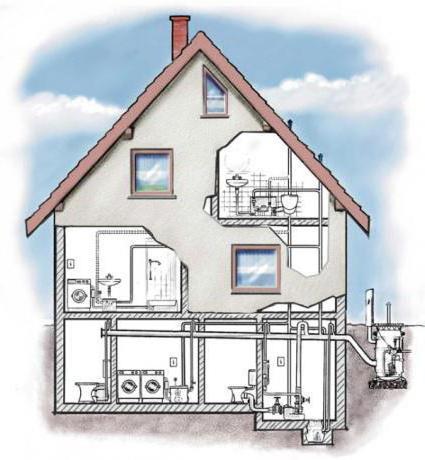
How to draw the right diagram
The sewerage scheme in a private house is an important stage. The quality of the system and its reliability depend on how well the plan is drawn up. Stages of drawing up a diagram:
- On a piece of paper, preferably in a box, you need to recreate the plan of the house. When drawing up a plan, it is worth considering the scale.
- Then it is worth deciding on the location of the riser or the collector pipe.
- At all levels of the building, the location of plumbing should be noted. At this stage, you should learn about how to connect it.
- From plumbing, it is necessary to lay pipes on paper to the riser. In this case, all connecting elements, tees, branches and corners should be taken into account.
- It is necessary to measure the length of each element of the internal system and summarize the data. The result is the required number of pipes. In this case, the diameter of the material must be taken into account.
The final stage is the drawing up of a diagram of the external system: the release of pipes, their laying to the septic tank. In this case, it is necessary to take into account all the requirements specified in SanPiN 2.1.4.1110-02, as well as SNiP 2.04.03-85.
What to consider when arranging an internal system
Laying in a private house begins after drawing up an approximate scheme. At this stage, there are several things to consider:
- To drain wastewater from the toilet, pipes with a diameter of 10-11 cm are required. Their total length must be at least 100 centimeters.
- For gray drains that enter the common riser from the kitchen and bathroom, pipes made of PP or PVC are required. The diameter of the material should be 5 centimeters.
- To arrange turns in the system, it is necessary to use several plastic elbows made at an angle of 45 °. This reduces the risk of blockages in the process of using the sewer.
- It is best to use polypropylene or PVC pipes for arranging sewage inside the house. Such material is more durable, reliable and relatively inexpensive. When using such pipes, laying sewers in a private house is simplified.
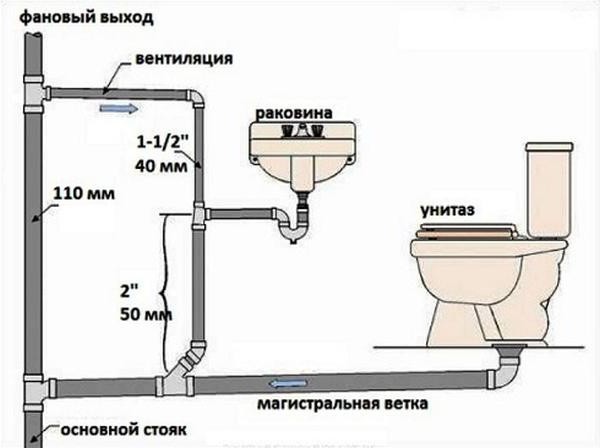
Choosing pipes
Laying sewerage in a private house requires careful preparation. After drawing up the scheme and carrying out the necessary calculations, the purchase of materials is required. For wiring inside the house, gray pipes are used. For the arrangement of the external system, pipes of an orange tint are required. You can explain the difference in color based on logic. Orange hues are best seen in the ground. In addition, pipes have differences in properties. First of all, it concerns the material. Pipes located underground must withstand more serious loads. The material for their manufacture should be more rigid.
For the installation to be successful, two-layer corrugated pipes can be used. But, as practice shows, their use is often inappropriate. After all, the depth of sewerage in a private house is from 2 to 3 meters. Much cheaper and no less effective is the use of orange pipes. Most often, a material with a diameter of 11 centimeters is used to equip an external system. This is quite enough for normal wastewater disposal.
How to lay pipes? It's simple!
Laying a sewer in a private house with your own hands requires certain skills and patience. The most difficult stage is the placement of pipes and their fastening. It is almost impossible to do this alone. Therefore, you will need an assistant to work. This will not only speed up the process, but also improve the quality.
The easiest option for laying sewerage is the use of PVC or PP pipes. A fairly wide range of such products is produced. If necessary, you can purchase material of the desired diameter, tees, elbows and revisions. It is worth noting that each part is equipped with a special rubberized insert - cuff. Thanks to this element, laying the sewerage of a private house takes a little time. Joints are connected easily and at the same time reliably. If desired, you can process the seams additionally. For this, a silicone-based plumbing sealant is suitable.
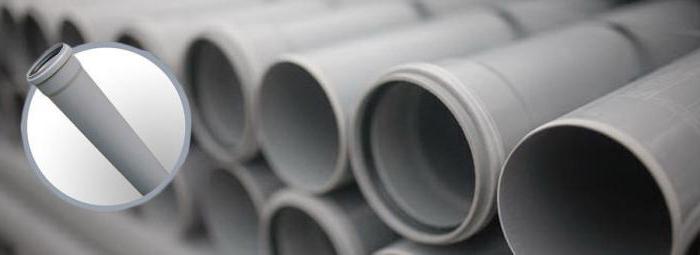
What to Consider
When laying pipes, it is necessary to take into account some nuances:
- If pipes run through walls or ceilings, then they must be placed in special sleeves that reduce the load on system fragments.
- The slope of the elements of the sewer system depends on their diameter and is prescribed in SNiP 2.04.03-85. For example, for a material whose diameter is 5 centimeters, this indicator should be 3 cm / m, and with a diameter of 10 to 11 centimeters - 2 cm / m.
Arrangement of sewer outlet
If a problem arises and the internal system does not match the external one, then the laying of sewer pipes in a private house should begin with the release. This is the boundary zone between systems. At this point, the riser is connected to the pipe leading to the wastewater collection tank.
It is necessary to mount the outlet through the foundation wall. The depth of its laying should be below the depth of soil freezing. Otherwise, in winter, difficulties may arise during the operation of the sewer. If the outlet hole was not specified during the construction of the building, then it will have to be punched. Its diameter must correspond to the dimensions of the pipe in the sleeve. The latter should be longer than the hole. From each edge, the sleeve must cover the pipe by more than 15 centimeters. These are the basic requirements for the release of sewage.
Installation of the riser and further wiring
The size of the pipe from the riser to the toilet should be 1000 mm. This allows you to determine its location. It is better to mount the riser in the toilet itself. Installation can be hidden or open. It all depends on where it will be carried out. You can install the riser close to the wall. To do this, use suspension brackets and clamps. You can also mount the pipe in a niche, in a channel or in a box.
To connect the riser and other fragments of the system, you can use oblique tees. If the pipes are different in diameter, then adapters should be used to connect them. They allow you to refuse the use of sealant. In those places where there is an intersection of elements coming from a shower, sink or bath, it is necessary to install a collector pipe. Its diameter should be from 10 to 11 centimeters. Do not forget about water seals. These elements do not allow unpleasant odors to penetrate into the living room.
On each floor, a revision is installed in the riser - a kind of tee designed to clean the system in case of severe blockage. 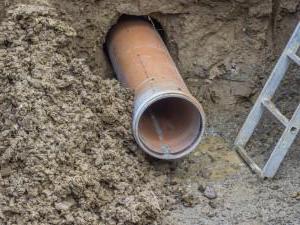
What is a fan pipe
By observing the rules for laying sewers in a private house, you can easily create an external and internal system. In addition to installing a riser, a fan pipe is also required. This is its continuation, which is displayed on the roof of the house. This part is installed on the riser. A revision is mounted at the junction. After that, the fan pipe is brought to the attic at an angle. Do not connect it to the ventilation system of the building or to the chimney.
The exhaust pipe should be located away from windows and doorways. This distance must be more than 4 meters. This fragment of the sewer should be located at different levels with a general ventilation of the house and a chimney. 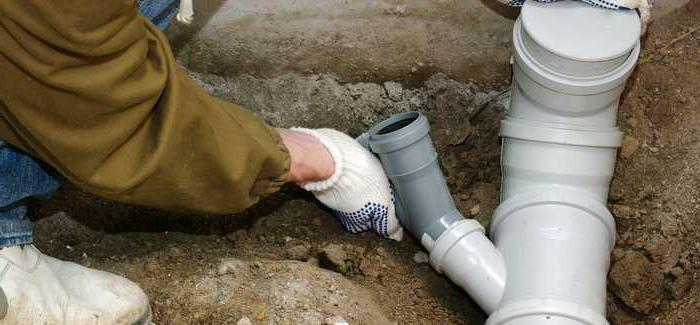
Types of septic tanks
Laying an external sewage system in a private house is no less important than installing an internal system. With improper arrangement, problems can arise not only with comfort, but also with environmentalists. One mistake can turn the sewer into a big smelly problem that will take a lot of time and money to fix.
You should start with a septic device. The most commonly used facilities are settling type. This is a container or a combination of them through which drains pass. Gradually they clear up. This occurs due to the deposition of heavy inclusions. After the drains pass additional purification in the filtration well or in the field. In this case, both mechanical and biological cleaning methods are used.
There is another, simpler type of septic tank - storage. In this case, a closed container of a sufficiently large volume is installed. All drains are collected in it. To empty such a septic tank, sewage pumping is required, which is carried out. This method of arranging an external system is easier to implement. Plus it's cheaper. 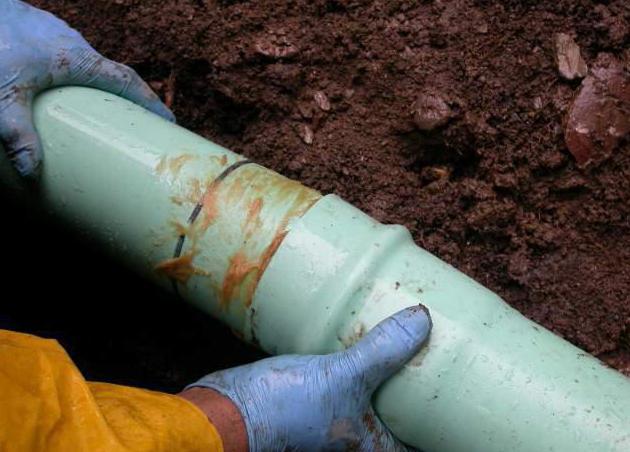
How to calculate the required volume
Calculating the size of the tank for a septic tank is not so difficult. The volume is determined based on settling for 3 days. The average consumption per person per day is 200 liters. If desired, this indicator can be calculated individually. If two people live in the house on a permanent basis, then the volume of the tank for the septic tank should be:
2 x 200 x 3 = 1200 liters or 1.2 cubic meters.
Stages of installation of an outdoor system
The laying of sewerage in a private house does not end after the complete installation of the internal system. After all, the arrangement of the outer part is required. Stages of arranging an external system:
- First you need to prepare the materials: a finished container of the required volume made of PP or reinforced concrete rings. If desired, you can lay out of brick or pour a monolith.
- The next step is to determine the appropriate wastewater treatment method.
- After earthworks are carried out: a pit is dug under the tank and trenches for laying pipes.
- All structural elements must be connected. At the same time, do not forget about the comfortable maintenance of the septic tank.
- Pipes should be mounted at a certain slope. This indicator should be 2 cm / m. Joints must be sealed.
- The septic tank should be equipped with a ventilation system.
- After carrying out work on thermal and waterproofing of individual fragments of the system, it is possible to fill the structure with soil.
When placing a septic tank, it is worth considering the location of the buildings on the plot. Do not place a waste container near a recreation area or playground.
In conclusion
Now you know how the sewerage pipes of a private house are laid. If you follow all the rules, you will get a reliable system. Before starting the operation of the sewer, it is necessary to carry out its run. To do this, the system must be flushed with clean water. This will identify any shortcomings and correct them. Only then can the operation of the sewer system be started.
In fact, the process of editing individual fragments is not difficult. The main thing is not to make mistakes when drawing up a sewerage scheme, as well as to make the correct slope of the pipes. Otherwise, the system will not function normally.









